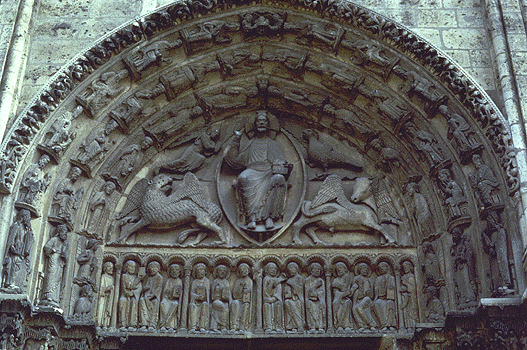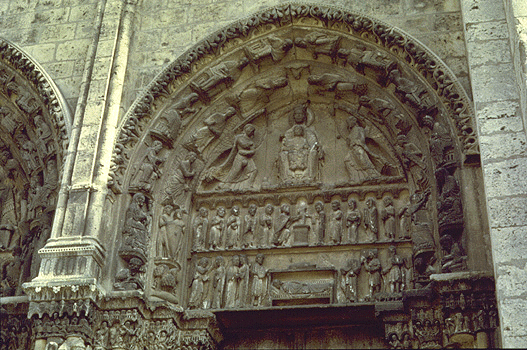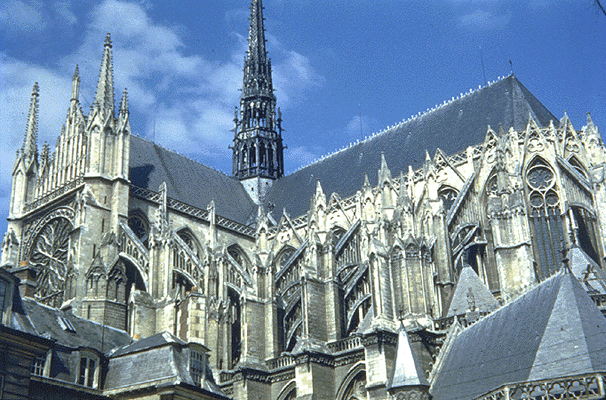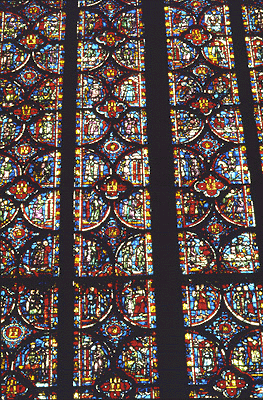GOTHIC ARCHITECTURE

Early Gothic 1140 -
1194
High Gothic 1194 - 1300
Late Gothic 1300 -
Whereas Romanesque culture was still primarily rural Gothic culture is an urban culture. The cities of Europe are in a
state of continuing revival that began during the
Romanesque period.
During the Romanesque period the
major religious centers are monasteries.
During the
Gothic period cathedrals, the seats of local bishops, became great centers
of education and political power.
It is during this time
that Paris becomes the intellectual center of Europe.
A crusade and inquisition against perceived heresies in southern
France served to create the unified kingdom of France as well as to
confirm the absolute power of the Papacy.
The rise of the popularity of the Cult of the Virgin Mary
leads to a new emphasis in the church on the role of Mary. She assumes
a status equal to that of great female dieties of the past such as Isis,
Demeter, Aphrodite and Hera. Prominent women such as Blanche of Castille
(above) and Eleanor of Aquitane
support literature and behavior that develops into the practice of "courtly
love" and chivalry. As a result women assume a much more prominent
role in society.
The Gothic style of architecture incorporates major advances in architecture:
- The combination of the
pointed, or Gothic, arch and the rib vault leads
to the ability to built higher vaults with more flexibility - The development of the
flying buttress leads to thinner and less massive
walls

|

Nave of St. Denis looking toward the choir |
In 1144 the royal abbey of St. Denis, outside Paris at this time, substantially remodeled by Abbot Suger (pronounced "soo zhay"), is rededicated.
St. Denis had the relics of
St. Denis the Apostle of Gaul. It was also the burial
place of the French kings.
Abbot Suger was a
counselor to kings Louis VI & VII
- and served
as regent when Louis VII went on crusade
At this
time the French kings directly controlled only the Ile de France - they
were not as powerful as the French dukes.
Suger
wanted to make St. Denis a spiritual center and used his royal connections
to accomplish this.
Abbot Suger substantially redesigned and remodeled the apse end of the abbey incorporating new ideas of vaulting - similar to the ribbed vaults we saw at St. Etienne and incorporating his own ideas regarding the spiritual nature of light.
At St. Denis, the radiating chapels rather than defining individual spaces (St. Sernin is a great example of this, go back and look at the floor plan) are integrated into one open, flowing space. This is integration of the various spaces is followed throughout the whole interior.
There is an emphasis on
geometry, luminosity, and the harmony of the parts with the
whole
The lightening of the structure allowed for
larger stained glass windows to flood the interior with mystical
light.
Whereas Romanesque buildings are defined by firmly grounded, solid masses, Gothic buildings are defined by space and their soaring verticality.
The Gothic style was seen as
very modern and it spreads throughout Europe.
However, artists and writers of the Renaissance saw it as crude,
bombastic, anti-classical
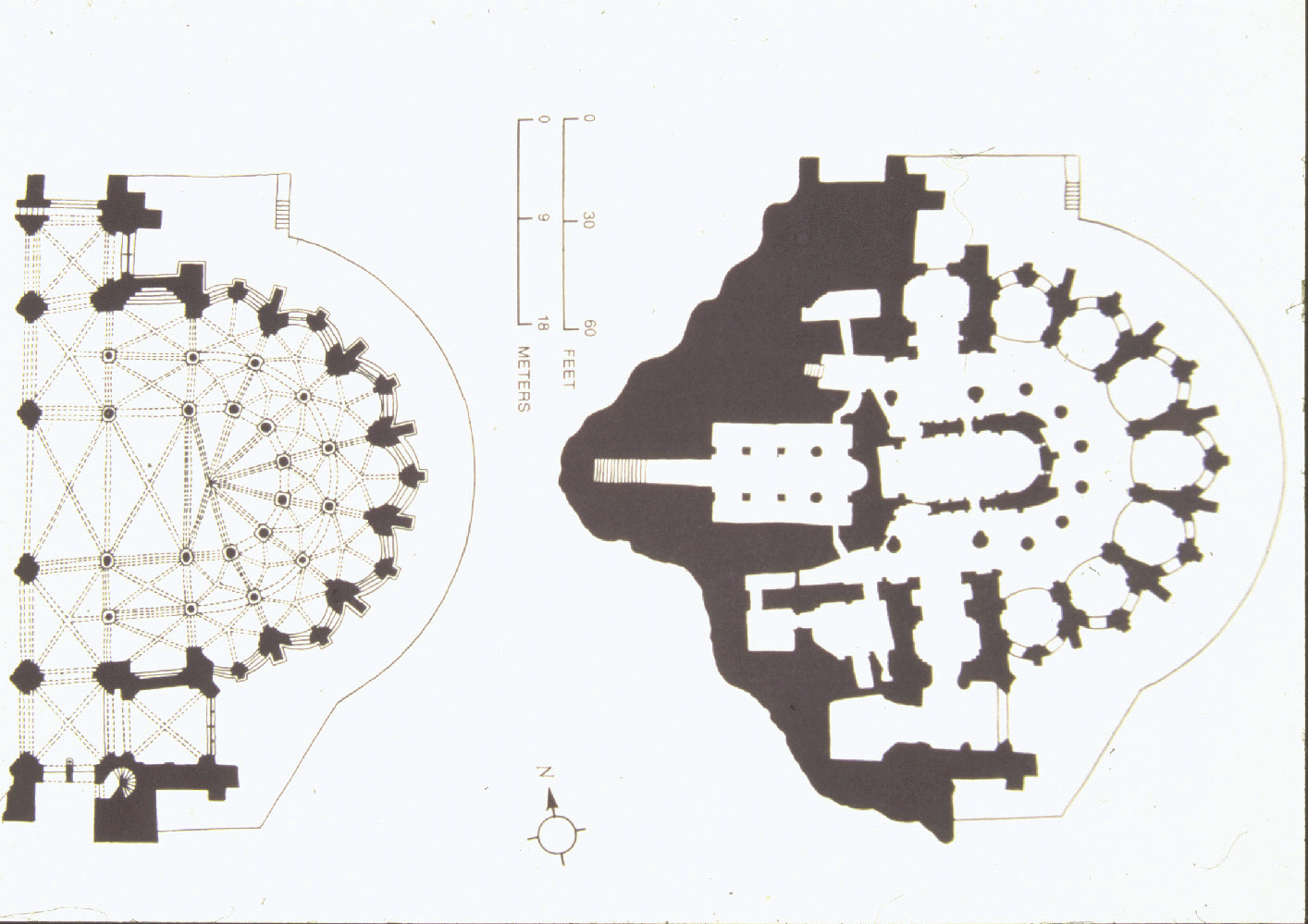
Suger rebuilt the east end of
the church using the existing crypt (a vaulted space beneath
a building) as the foundation
The design unifies the radiating chapels and the ambulatory with a
single
structural system unlike the Romanesque system of creating discrete,
compartmentalized spaces
- the apse, chapels
and ambulatory were all unified
- the supporting
system of columns and arches was reduced in
mass
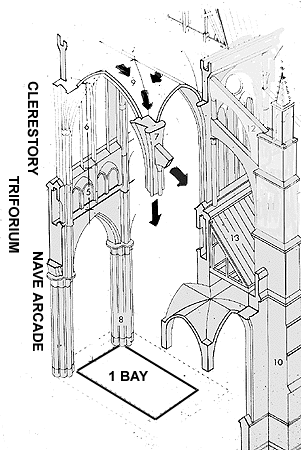
Generalized axometric
section |
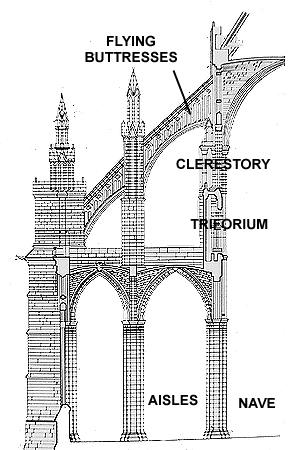
Cross section through the
structure of |
Suger was able to he did this
by moving most of the support to the exterior,
This
was able to be done by lightening the walls and directing the thrust of
the arches through the buttresses
- using ribbed
groin vaults and pointed arches
- this creates an
open airy interior - but a massive exterior
- interior piers line up
with exterior buttresses
Round arches are as high as
they are wide - semi-circle
- giving a dome like
effect - a smaller arch canít have the same elevation
as a larger one
Using the pointed arch space
can flow together, more unified
- also the ability
to use a larger clerestory
- and with the reduced
walls/piers larger windows in the aisles
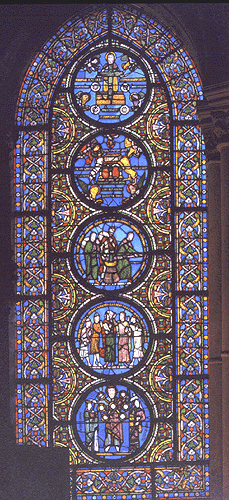 Anagogical window, St.
Denis
Anagogical window, St.
Denis
Anagogy refers to an interpretation of scripture that
goes beyond the literal meaning and indicates a higher, metaphysical,
level of spiritual consciousness.
The light admitted by the stained
glass was seen by Suger as "the light Divine"
- the true essence of
God
Suger was influenced by the
writings of a 5th c. mystic, St. Dionysius
-
concerning the mystical, metaphysical properties of light
He wanted to develop architecture which emphasized these properties
by allowing for greater window area
- a visible
manifestation of Godís presence
- you can see it
and feel it, but you canít touch it
- Jesus as the
light of the world
The use of stained glass is a
metaphor
Holy Spirit --> Virgin Mary :: Light
--> Glass
The glass transmutes the light
creating a very otherworldly effect
- inviting
contemplation and allowing the soul to come into union with the presence
of God
CHARTRES CATHEDRAL 1194 -
1220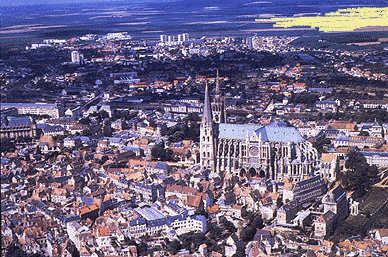
The Bishop of Chartres was a
friend of Suger and incorporated his ideas into the rebuilding of Chartres
cathedral which began in 1145
Chartresí most
venerated relic is the mantle of the Virgin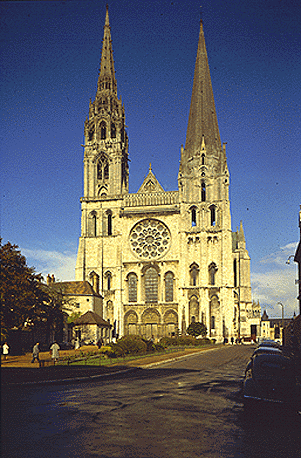
In 1193 there was a fire
which destroyed all but the facade and the crypt
In
1194 rebuilding was begun, and completed in only 26 years
North tower built in 16th c.
Because of
these stages of building Chartres shows an
evolutionary process in the building from the Early Gothic western facade
to the south portals built last.
An outstanding Web site on Chartres
Inside this outstanding site the glass windows
Check these out!
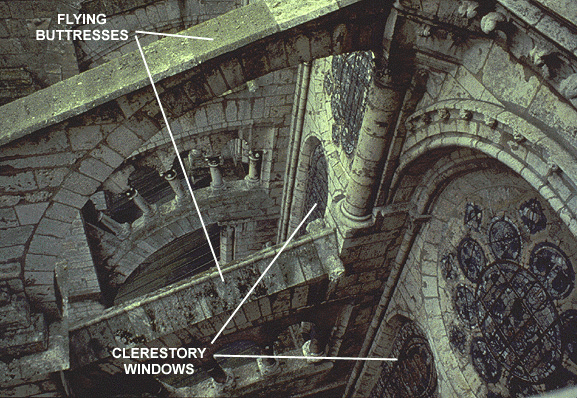
Chartres was the first church where flying buttresses were used integrally from the beginning of the design and building process
Chartres also begins a move
to a more rectangular bay system with smaller, 4 part rib
vaults
- this creates a more unifies appearance in
the interior, a continuous
hall
Also, the choir and apse were enlarged into a chevet
("sh vay") and it is equal to, or larger in area than the nave
itself
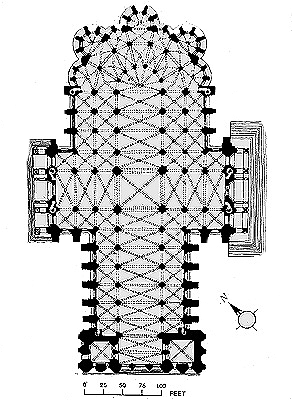
Chartres plan
The plan shows a fluid, unified space, unlike the compartmentalized interiors of Romanesque churches

Nave
The interior elevation is
simplified from the Early Gothic four part elevation
Early Gothic -nave arcade - gallery - triforium -
clerestory
High Gothic- three part
elevation
- eliminating the gallery and enlarging the
clerestory
The nave arcade is 40í high
The
triforium is 20í high
The clerestory is 40í high
 North Transept Rose
Window
North Transept Rose
Window
Rose window is 42í in
dia.
In the center Mary and infant Christ
enthroned. The surrounding panels all
number twelve:
1st set - four doves and eight
angels
2nd set - squares - twelve old
testament kings - precursors to Christ
-
quatrefoils gold lilies on blue field
- symbol of French
kings
- outer circle - old testament prophets
(-->apostles)
Lancets
-
St. Anne and baby Mary
- 2 old testament
prophets
- King David & King Solomon
Small windows between
are
royal coats of arms - proclaim the divine right
to rule of the French kings
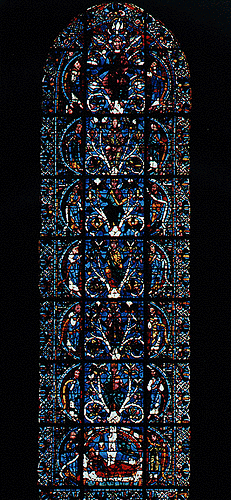 |
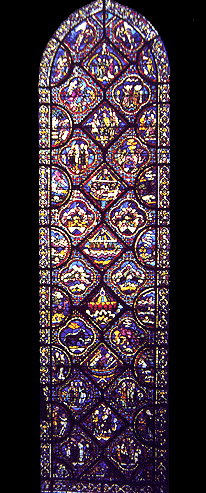 |
| Tree of Jesse Window | Noah Window |
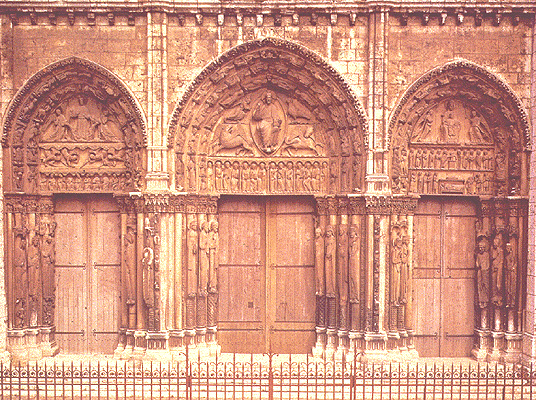
CHARTRES: The Western Portals
Facade is Early Gothic
1140-1150.
Base of north tower 1134
South tower 1142
Portals c.
1145-50,
Preserved from the fire of
1194
- reinstalled in a new location on a level
with the front of the existing towers, also preserved from the 1194
fire.
Rose Window early 13th
century
North spire 1507-13 (by Jehan de
Beauce)
Figures are well integrated with the
architecture and they also stand as individuals
-
an innovation of Suger
Representing the kings,
queens and prophets of the Old Testament
- during
the French Revolution the jamb statues of St. Denis and
the Cathedral of Paris were destroyed because people thought
they were the kings and queens of
France
Center Portal & Tympanum
Tympanum: Christ enthroned as judge and ruler of the
universe w/ four evangelists
Lintel: 12 standing
apostles and two extra figure probably Elijah and Enoch
Voussiors: 24 seated elders holding
musical instruments: Old Testament prophets
Capitals: Life of Christ
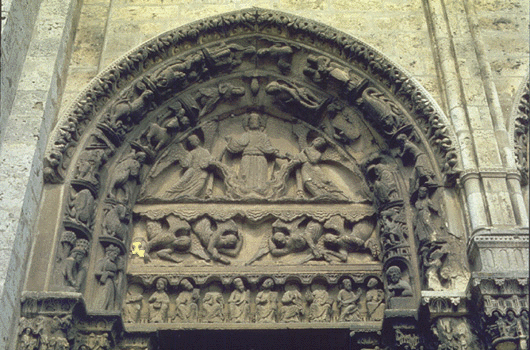
North Portal & Tympanum
Tympanum: timeless
heavenly Christ ascendant in a cloud held by two angels.
Different scholars offer different interpretations:
-Ascension of Christ,-Christ as Creator of the universe, Christ's
Second Coming
Lintel: 12 seated
apostles
Voussoirs: Labors of the months and
signs of the Zodiac
Capitals: Christ's
childhood
Jambs: Old Testament kings,
queens, and prophets, not individually identifiable
South Portal & Tympanum
(click on the image for a closer view)
Tympanum: The Virgin and Child enthroned (Throne of Wisdom
or Sedes Sapientiae) between by two
angels
Upper lintel: Presentation of Christ
in the Temple
Lower lintel : Infancy of
Christ: Annunciation, Visitation,
Nativity,
Annunciation to the Shepherds
Voussiors and
Jambs: Old Testament kings, queens, prophets, not
individually identifiable
 |
 |
Jamb Statues
Old testament prophets
Compare
with Jeremiah fr. Moissac
- There is a re-awakened interest in the
naturalistic depiction of the
figure
- still elongated but
calmer
- standing on platforms, feet donít
dangle
- drapery is a pattern but shows some
logic
- Jeremiah is embedded in the stone Chartres
figures stand out
- And a unifying scheme to
sculptural programs which include
symbols and
figures from other realms of medieval writing, not just
theological
- the figures interact with each
other
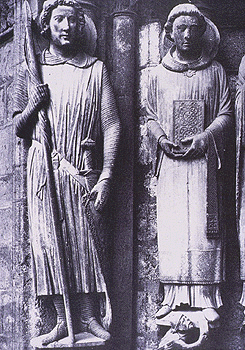
St. Theodore fr. South transept portal
Notre Dame de Paris
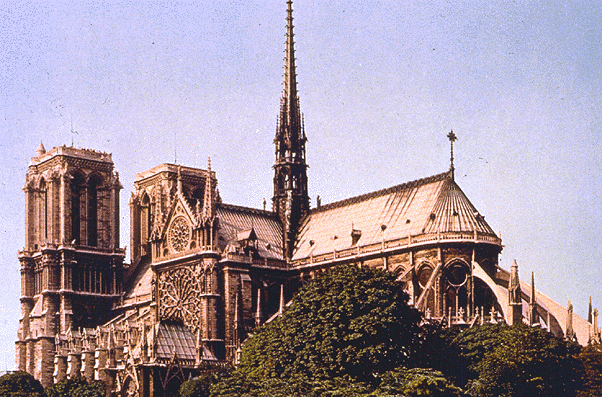
Notre Dame, Paris, view
fr. south
1163 - 1250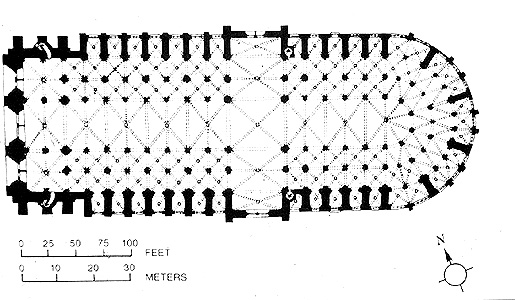
Notre Dame has an interesting combination of Early and Late Gothic characteristics.
During construction chapels
were added between the buttresses
AMIENS
CATHEDRAL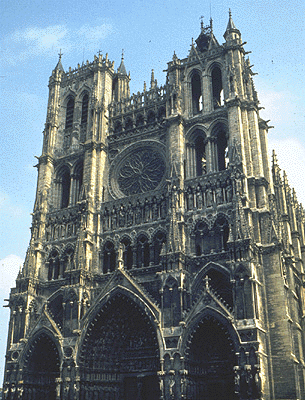
Amiens
cathedral was begun in 1220
- nave was finished
in 1236
South tower dates from 14th c. - north
tower from 15th c.
The portals correspond directly
to the interior spaces behind them
- also in
elevation the facade corresponds to the interior
-
portals -> nave - small arches and kings ->
triforium
- rose window ->
clerestory
Very rich surface
decoration
- many openings and colenettes, arches
and pinnacles
Amiens South transept and choir, note the elegant flying buttresses, click here for a closer view
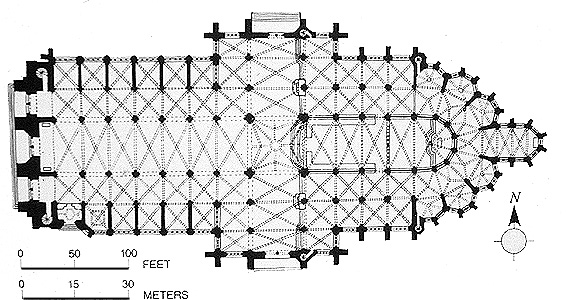
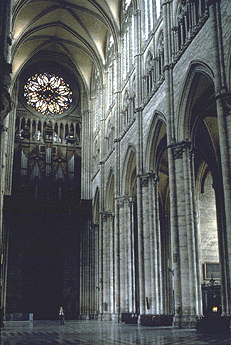 |
 |
| Looking west in the nave of Amiens | Looking east in the nave of Amiens |
 |
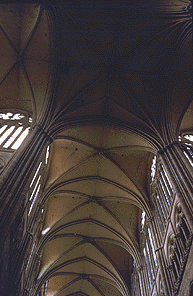 |
View of the choir and its vaults. The vaults are 144í in height.
THE RAYONNANT STYLE
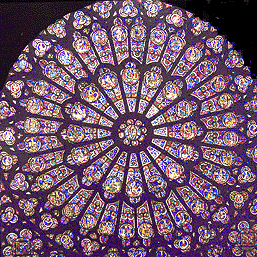
North Transept Rose
Window
1240 - 1250, 43'
diameter
The large amounts of tracery
that are integral to the design of this rose window from Notre Dame are
representative of the Rayonnant ("radiant")
Style of stained glass. The style was rich and opulent in
its design and was associated with the royal court. There was an emphasis
on more and lighter tracery
The North Rose Window
of Notre Dame was described as a "multi-foliate rose of
light"
At the center is Mary as mother of
Christ
- 32 Old Testament Kings
- 32 high priests and patriarchs
Predominant
color of the window is blue, color of the northern sky and of Maryís
mantle as Queen of the Heavens
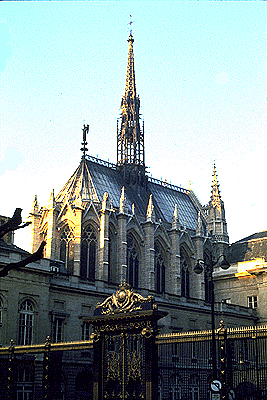 Ste. Chapelle
Ste. Chapelle
1243 - 1248
St. Chapelle was designed as
a repository of the relics of Christ brought back by Saint Louis
after the 6th Crusade. The exterior was designed
to resemble a reliquary.
The interior looks as if one were inside a
jewel box.
More than 3/4 of the structure is
stained glass the whole experience is one of many slender and
linear forms
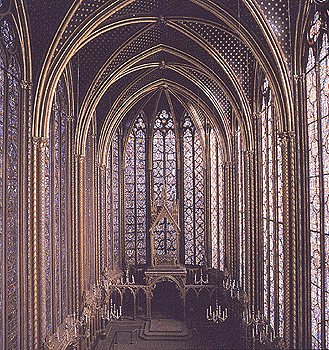 |
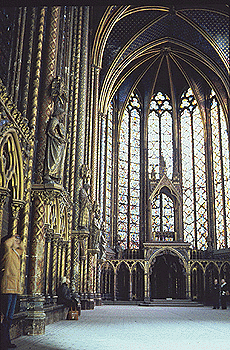 |
